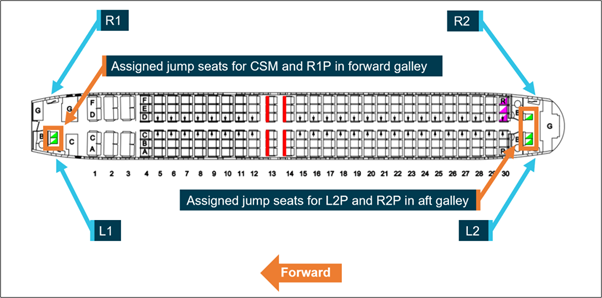
A Qantas 737 landed with four people out of their seats assisting a cabin crew member injured after the aircraft encountered severe unexpected turbulence, an ATSB investigation report details.
The 737 passenger service from Sydney to Brisbane on 4 May 2024 encountered the severe turbulence as the aircraft descended in cloud through about 11,400 ft, in the minute after the flight crew had turned on the seatbelt signs.
While anticipating some mild turbulence, the captain did not communicate to the cabin crew about expected turbulence during descent, likely as a result of not knowing its severity.
“After the seatbelt signs were illuminated, per operator procedures, the cabin crew were performing various duties such as checking lavatories were empty and ensuring all passengers were seated when the severe turbulence was encountered,” ATSB Director Transport Safety Dr Stuart Godley said.
During the event, two of the four cabin crew sustained minor injuries, while a third sustained a fractured ankle and was unable to move from the rear galley floor.
Two cabin crew (including the customer service manager) and two passengers (one of whom was an off-duty cabin crew employee, the other a travelling doctor) remained with the injured cabin crew member in the rear galley, unrestrained, during the landing.
“Qantas 737 standard operating procedures rely on the customer service manager – the senior member of the cabin crew – informing the flight crew if the cabin is not secured for landing,” Dr Godley explained.
While the CSM contacted the captain to inform them about the injured cabin crew member and that some passengers were standing, the captain did not recall receiving any requests for more time to prepare the cabin for landing, and twice directed all uninjured cabin crew and passengers to return to their seats.
“Landing is a critical phase of flight, and the unrestrained cabin crew and passengers were exposed to a higher risk of injury in a landing-based emergency, which in turn would have compromised the cabin crew’s ability to manage any such emergency situation,” Dr Godley said.
“Data shows that almost 80% of serious turbulence-related injuries in airline operations are sustained by cabin crew, and the most common time for these to occur is when preparing the cabin for landing.”
Collaboration between pilots and cabin crew helps ensure the timely completion of service-related tasks while minimising the risk of injury during known or anticipated encounters with turbulence, Dr Godley noted.
“Differing understandings of the state of the cabin increases the risk of delayed responses or misaligned decision‑making, which may lead to safety being compromised.”
Shortly after the aircraft’s arrival at the gate at Brisbane, the seriously injured cabin crew member was attended to by ambulance personnel.
However, the report notes, the other two injured cabin crew members did not receive any immediate follow up medical assessments or treatment.
While one of the injured crew self-diagnosed their facial injury the next day, the other was unaware they had sustained a concussion and operated on multiple flights while experiencing concussion symptoms before being treated.
Qantas has subsequently updated its post-event incident notification protocol to include contact with the Qantas on-call doctor in the event of significant cabin crew injury or illness.
Additionally, the airline has implemented additional controls to adequately assess the fitness of crew members after a turbulence event or other unplanned aircraft movement.
Read the final report: Turbulence event and cabin crew injury involving Boeing 737, VH-VYK, 36 km south-east of Brisbane Airport, Queensland, on 4 May 2024


